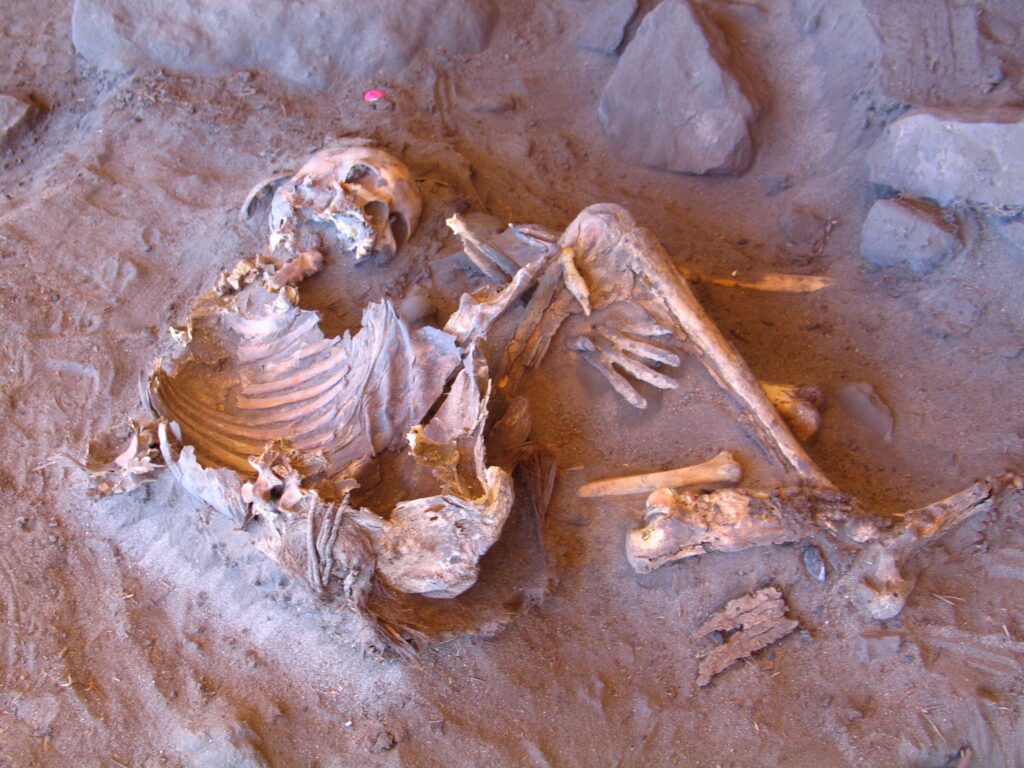A groundbreaking study led by an international team of researchers from the Max Planck Institute for Evolutionary Anthropology in Leipzig, Germany, has provided fresh insights into the mysterious history of North Africa during a period when the Sahara was transformed from a vast, arid desert into a lush, savanna-like environment teeming with life. The findings, published in Nature, offer a new perspective on human migration patterns, cultural exchange, and the development of early pastoral societies in the Green Sahara, a phase that occurred roughly 7,000 years ago.
Through the sequencing of ancient genomes from two naturally mummified individuals found in the Takarkori rock shelter in southwestern Libya, the research team has uncovered fascinating details about a long-isolated, now-extinct human lineage in North Africa. These individuals, who lived in the heart of the Green Sahara, are direct descendants of a population that diverged from sub-Saharan African ancestors around the same time that modern humans began their exodus from Africa approximately 50,000 years ago.
The Green Sahara: A Window into Africa’s Prehistoric Past
The African Humid Period, spanning from about 14,500 to 5,000 years ago, was a time when the Sahara Desert, today the largest hot desert in the world, was a far cry from the arid, barren expanse we know today. During this era, the region was transformed into a verdant savanna, rich in water bodies that supported diverse ecosystems and human populations. This humid phase played a crucial role in the spread of early human societies, including the practice of animal husbandry, which is central to the study’s findings.
However, with the onset of rapid climate changes and increasing aridity, the once thriving region began to dry up, eventually turning into the desert that dominates northern Africa today. The extreme dryness of the Sahara today has made the preservation of ancient DNA incredibly difficult. As a result, this new study, which successfully sequenced the genomes of two individuals from this period, is not only pioneering but also provides invaluable data about ancient North African populations.
Ancient Genomic Insights: A Window into the Past
The two individuals whose genomes were analyzed in the study were excavated from the Takarkori rock shelter, a key archaeological site in the Libyan Sahara. These naturally mummified remains, dating back to around 7,000 years ago, belong to a group of cattle pastoralists who lived in the Green Sahara. Their DNA reveals startling details about their ancestry, population movements, and cultural practices.


One of the most significant findings is that the genetic lineage of these individuals traces back to a population that was genetically distinct from both sub-Saharan Africans and populations outside of Africa. The researchers found that this lineage diverged from sub-Saharan African populations at approximately the same time as the lineages of modern humans that dispersed from Africa to other continents. This suggests that while the Green Sahara was a thriving habitat for humans, it was genetically isolated from other African populations, allowing the North African lineage to evolve separately for thousands of years.
This lineage, though no longer present in its pure form, continues to influence the genetic makeup of modern North African populations. These findings highlight the unique and enduring genetic heritage of North African people and demonstrate that this region harbors a deep and rich history of human adaptation.
The Spread of Pastoralism: Cultural Exchange Over Migration
One of the study’s key revelations is the role of cultural exchange in the spread of pastoralism in the Green Sahara. Contrary to earlier theories that suggested large-scale migrations were responsible for the spread of cattle herding in the region, the new genetic evidence points to a more complex picture. The Takarkori individuals, who were part of the pastoralist communities of the Green Sahara, have only a minor genetic component from non-African sources. This finding suggests that the practice of animal husbandry likely spread through cultural exchange rather than through large-scale population movements.
This conclusion challenges previous assumptions about the diffusion of pastoralism and raises important questions about the role of cultural interactions in shaping human history. The spread of pastoralism in the Green Sahara likely involved the sharing of knowledge and practices between different groups living in the region, rather than the movement of entire populations. This finding is significant because it helps to refine our understanding of how early human societies developed complex subsistence strategies in response to their environments.
Limited Gene Flow Between Sub-Saharan and North African Populations
The study also provides new insights into the relationship between sub-Saharan and North African populations during the African Humid Period. Previous theories had suggested that the Sahara acted as a corridor for gene flow between these two regions, particularly during the Green Sahara phase when the desert was more hospitable. However, the genetic data from the Takarkori individuals indicate that gene flow between sub-Saharan and North African populations remained minimal during this time.
Despite the Sahara’s transformation into a more favorable environment for human habitation, the individuals in the study were genetically distant from sub-Saharan African populations. This finding suggests that, although the Green Sahara may have facilitated some human movement, it did not serve as a major conduit for the mixing of populations from the two regions. This challenges previous interpretations that assumed the Sahara functioned as a bridge between the north and south of the continent during this period.
Neandertal Ancestry: Traces of the Past
Another intriguing aspect of the study is the presence of Neandertal ancestry in the genomes of the Takarkori individuals. While Neandertal DNA is present in many non-African populations today due to ancient interbreeding events, the Takarkori individuals possess significantly less Neandertal DNA than populations outside of Africa, but more than contemporary sub-Saharan Africans.
This finding suggests that while early North African populations were largely isolated, they still experienced some gene flow from outside Africa, likely from populations that had already interacted with Neandertals. This limited gene flow is consistent with the idea that the ancestors of modern North Africans retained some genetic legacy from the Neandertal populations that once inhabited Europe and Asia.
The Role of Ancient DNA in Reconstructing Human History
The significance of this study extends beyond the Sahara’s past—it also underscores the importance of ancient DNA in reconstructing human history. The unique genetic legacy uncovered in the Takarkori individuals offers crucial insights into the peopling of North Africa and the development of early cultures in the region. By analyzing ancient genomes, researchers can gain a more nuanced understanding of human migration patterns, adaptations to changing environments, and the cultural innovations that shaped early societies.
As senior author Johannes Krause, director at the Max Planck Institute for Evolutionary Anthropology, notes, “Our findings suggest that while early North African populations were largely isolated, they received traces of Neandertal DNA due to gene flow from outside Africa.” This statement emphasizes the importance of ancient DNA studies in unveiling the complex tapestry of human history, particularly in regions like North Africa, where archaeological evidence has been difficult to preserve.
A New Chapter in North African Prehistory
This study not only deepens our understanding of the prehistoric Sahara but also challenges long-held assumptions about the development of early human societies in Africa. By analyzing the genomes of these ancient individuals, the researchers have painted a clearer picture of the Green Sahara and its role in the broader narrative of human history.
The findings reveal a deeply rooted and long-isolated genetic lineage in North Africa, highlighting the resilience of these ancient populations in the face of dramatic environmental changes. The study also sheds new light on the spread of pastoralism, suggesting that cultural exchange played a more prominent role than previously thought.
As senior author Savino di Lernia from Sapienza University in Rome concludes, “By shedding light on the Sahara’s deep past, we aim to increase our knowledge of human migrations, adaptations, and cultural evolution in this key region.”
This pioneering research is a testament to the power of ancient DNA in unraveling the mysteries of human prehistory. The discoveries made in the Takarkori rock shelter offer new perspectives on the people who once thrived in the Green Sahara, providing a crucial piece of the puzzle in the complex history of North Africa and the development of early human societies.
Reference: Ancient DNA from the Green Sahara reveals ancestral North African lineage, Nature (2025). DOI: 10.1038/s41586-025-08793-7
